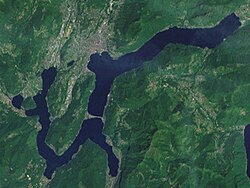Lake Lugano
| Lake Lugano Lago di Lugano |
|
|---|---|

Satellite image of Lake Lugano
|
|
| Location | Ticino, Lombardy |
| Coordinates | 45°59′N 8°58′E / 45.983°N 8.967°ECoordinates: 45°59′N 8°58′E / 45.983°N 8.967°E |
| Primary inflows | Vedeggio, Cassarate, Cuccio, Laveggio, Magliasina, Bolletta, Scairolo |
| Primary outflows | Tresa |
| Catchment area | 565.6 km2 (218.4 sq mi) |
| Basin countries | Switzerland, Italy |
| Surface area | 48.7 km2 (18.8 sq mi) |
| Average depth | 134 m (440 ft) |
| Max. depth | 288 m (945 ft) |
| Water volume | 6.5 km3 (1.6 cu mi) |
| Residence time | 8.2 years |
| Surface elevation | 271 m (889 ft) |
| Sections/sub-basins | North basin, South basin, Ponte Tresa |
| Settlements | Lugano, Melide, Campione d'Italia, Ponte Tresa |
Lake Lugano (Italian: Lago di Lugano or Ceresio, from Ceresius lacus) is a glacial lake which is situated on the border between southern Switzerland and northern Italy. The lake, named after the city of Lugano, is situated between Lake Como and Lago Maggiore. It was cited for the first time by Gregory of Tours in 590 with the name Ceresio, a name which is said to have derived from the Latin word cerasus, meaning cherry, and refers to the abundance of cherry trees which at one time adorned the shores of the lake. The lake appears in documents in 804 under the name Laco Luanasco.
Well-known mountains and tourist destinations on the shores of the lake are Monte Brè to the east, Monte San Salvatore west of Lugano, and Monte Generoso on the south-east shore. The World Heritage Site Monte San Giorgio is situated south of the lake.
The first certain testimony of a political body governing the shores of the lake is from 818. Occupying an area of strategic importance, the lake was then part of the feudal dominion of the County of Sperio. Circa 1000, it came under the control of the Bishop of Como. The region was the site of the war between Como and Milan over control of Alpine traffic from 1218 to 1227. As the lake and its shores became progressively incorporated into the Duchy of Milan they became the subject of political and territorial contention during the 15th century, and Lugano became the lake's main town.
...
Wikipedia
